Striving to Be Different but Becoming the Same: Creativity and Destination Brands’ Promotional Videos
Abstract
1. Introduction
1.1. Destination Branding, YouTube and the Need for Creativity
1.2. Challenges of Analysing Advertisement Creativity on YouTube
2. Materials and Methods
3. Results and Discussion
3.1. Fluency and Flexibility: “Our Destination Has so Much to Offer! Ours Too!”
3.2. Originality: If Each and Every Destination Is Unique How Can One Stand Out?
3.3. Elaboration: Tell Me a (Funny) Story
4. Conclusions
Author Contributions
Funding
Institutional Review Board Statement
Informed Consent Statement
Data Availability Statement
Conflicts of Interest
References
- Richards, G.; Wilson, J. Developing creativity in tourist experiences: A solution to the serial reproduction of culture? Tour. Manag. 2006, 27, 1209–1223. [Google Scholar] [CrossRef]
- Richards, G. Creativity and tourism: The state of the art. Ann. Tour. Res. 2011, 38, 1225–1253. [Google Scholar] [CrossRef]
- Baack, D.W.; Wilson, R.T.; Van Dessel, M.M.; Patti, C.H. Advertising to businesses: Does creativity matter? Ind. Mark. Manag. 2016, 55, 169–177. [Google Scholar] [CrossRef]
- El-Murad, J.; West, D.C. The Definition and Measurement of Creativity: What Do We Know? J. Advert. Res. 2004, 44, 188–201. [Google Scholar] [CrossRef]
- Yang, X.; Smith, R.E. Beyond Attention Effects: Modeling the Persuasive and Emotional Effects of Advertising Creativity. Mark. Sci. 2009, 28, 935–949. [Google Scholar] [CrossRef]
- Reinartz, W.; Saffert, P. Creativity in advertising: When it works and when it doesn’t. Harv. Bus. Rev. 2013, 91, 106–112. [Google Scholar]
- Andrews, J. It’s Funny You Should Ask: An Examination of Professionals’ Perceptions of the Use of Humor in Advertising. Master’s Thesis, Faculty of the Graduate School, University of Missouri-Columbia, Columbia, MO, USA, 2019. [Google Scholar]
- Turnšek, M.; Janecek, P. “America First, the Netherlands Second” on YouTube: “spoofing” destination marketing with political satire. Eur. J. Humour Res. 2019, 7, 26–45. [Google Scholar] [CrossRef]
- Bex, T. The Genre of Advertising. Rev. Belg. Philol. D’histoire 1993, 71, 719–732. [Google Scholar] [CrossRef]
- Pike, S.D.; Page, S.J. Destination Marketing Organizations and destination marketing: A narrative analysis of the literature. Tour. Manag. 2014, 41, 202–227. [Google Scholar] [CrossRef]
- Fyall, A.; Garrod, B.J.; Wang, Y. Destination collaboration: A critical review of theoretical approaches to a multi-dimensional phenomenon. J. Destin. Mark. Manag. 2012, 1, 10–26. [Google Scholar] [CrossRef]
- Morrison, A. Destination management and destination marketing: The platform for excellence in tourism destinations. Tour. Trib. 2013, 28, 6–9. [Google Scholar]
- Sotiriadis, M.; Shen, S. The contribution of partnership and branding to destination management in a globalized context: The case of the UNWTO Silk Road Programme. J. Tour. Herit. Serv. Mark. 2017, 3, 8–16. [Google Scholar]
- Perrin, A. Social Media Usage; Pew Research Center: Washington, DC, USA, 2015; pp. 52–68. [Google Scholar]
- Zeng, B.; Gerritsen, R. What do we know about social media in tourism? A review. Tour. Manag. Perspect. 2014, 10, 27–36. [Google Scholar] [CrossRef]
- Leung, D.; Law, R.; Van Hoof, H.; Buhalis, D. Social Media in Tourism and Hospitality: A Literature Review. J. Travel Tour. Mark. 2013, 30, 3–22. [Google Scholar] [CrossRef]
- Tsimonis, G.; Dimitriadis, S. Brand strategies in social media. Mark. Intell. Plan. 2014, 32, 328–344. [Google Scholar] [CrossRef]
- Hays, S.; Page, S.J.; Buhalis, D. Social media as a destination marketing tool: Its use by national tourism organisations. Curr. Issues Tour. 2013, 16, 211–239. [Google Scholar] [CrossRef]
- Hutter, K.; Hautz, J.; Dennhardt, S.; Füller, J. The impact of user interactions in social media on brand awareness and purchase intention: The case of MINI on Facebook. J. Prod. Brand Manag. 2013, 22, 342–351. [Google Scholar] [CrossRef]
- Stojanovic, I.; Andreu, L.; Curras-Perez, R. Effects of the intensity of use of social media on brand equity: An empirical study in a tourist destination. Eur. J. Manag. Bus. Econ. 2018, 27, 83–100. [Google Scholar] [CrossRef]
- Mehmood, I.; Sajjad, M.; Rho, S.; Baik, S.W. Divide-and-conquer based summarization framework for extracting affective video content. Neurocomputing 2016, 174, 393–403. [Google Scholar] [CrossRef]
- Babin, L.A.; Burns, A.C. Effects of Print Ad Pictures and Copy Containing Instructions to Imagine on Mental Imagery That Mediates Attitudes. J. Advert. 1997, 26, 33–44. [Google Scholar] [CrossRef]
- Celikkale, B.; Erdem, A.; Erdem, E. Visual Attention-Driven Spatial Pooling for Image Memorability. In Proceedings of the 2013 IEEE Conference on Computer Vision and Pattern Recognition Workshops, Portland, OR, USA, 23–28 June 2013; pp. 976–983. [Google Scholar]
- Dehghani, M.; Niaki, M.K.; Ramezani, I.; Sali, R. Evaluating the influence of YouTube advertising for attraction of young customers. Comput. Hum. Behav. 2016, 59, 165–172. [Google Scholar] [CrossRef]
- Uşaklı, A.; Koç, B.; Sönmez, S. How ’social’ are destinations? Examining European DMO social media usage. J. Destin. Mark. Manag. 2017, 6, 136–149. [Google Scholar] [CrossRef]
- Turnšek Hančič, T.; Kurež, B.; Brumen, B.; Rosi, M.; Rangus, M. The political economy of social media: What does it mean for tourism? The case of YouTube. Acad. Tur. 2013, 6, 17–75. [Google Scholar]
- Huang, J.; Su, S.; Zhou, L.; Liu, X. Attitude toward the viral ad: Expanding traditional advertising models to interactive advertising. J. Interact. Mark. 2013, 27, 36–46. [Google Scholar] [CrossRef]
- Huertas, A.; Míguez-González, M.-I.; Lozano-Monterrubio, N. YouTube usage by Spanish tourist destinations as a tool to communicate their identities and brands. J. Brand Manag. 2017, 24, 211–229. [Google Scholar] [CrossRef]
- Algie, J.; Mead, N. Fun ways to engage with rail safety through the dumb ways to die social marketing campaign. In Customer Relationship Management; Springer Science and Business Media LLC: Berlin/Heidelberg, Germany, 2019; pp. 93–110. [Google Scholar]
- Jenkins, H.; Green, J.; Hartley, J.; Burgess, J. YouTube: Online Video and Participatory Culture; Polity Press: Cambridge, MA, USA, 2013. [Google Scholar]
- Molnár, V. Reframing public space through digital mobilization: Flash mobs and contemporary urban youth culture. Space Cult. 2014, 17, 43–58. [Google Scholar] [CrossRef]
- Shifman, L. An anatomy of a YouTube meme. New Media Soc. 2012, 14, 187–203. [Google Scholar] [CrossRef]
- Torrance, E.P. Scientific views of creativity and factors affecting its growth. Daedalus 1965, 94, 663–681. [Google Scholar]
- Fletcher, W. The Management of Creativity. Int. J. Advert. 1990, 9, 1–37. [Google Scholar] [CrossRef]
- Young, A.P. Visual methodologies: An introduction to the interpretation of visual methods (2nd ed.). Libr. Inf. Sci. Res. 2009, 31, 72. [Google Scholar] [CrossRef]
- Jordanous, A. Stepping back to progress forwards: Setting standards for meta- evaluation of computational creativity. In Proceedings of the 5th International Conference on Computational Creativity, Association for Computational Creativity, Ljubljana, Slovenia, 10–13 June 2014; pp. 129–136. [Google Scholar]
- Lubart, T.I. 17 Creativity across cultures. In Handbook of Creativity; Cambridge University Press: Cambridge, UK, 1999; pp. 339–350. [Google Scholar]
- Krippendorff, K. Content Analysis: An Introduction to Its Methodology; Sage: London, UK, 2004. [Google Scholar]
- Lamb, C.; Brown, D.G.; Clarke, C.L. Evaluating computational creativity: An interdisciplinary tutorial. Acm Comput. Surv. (Csur) 2018, 51, 1–34. [Google Scholar] [CrossRef]
- Hekkert, P.P.; Snelders, H.D.; Van Wieringen, P.C.W. ‘Most advanced, yet acceptable’: Typicality and novelty as joint predictors of aesthetic preference in industrial design. Br. J. Psychol. 2003, 94, 111–124. [Google Scholar] [CrossRef] [PubMed]
- Guilford, J.P. The structure of intellect. Psychol. Bull. 1956, 53, 267. [Google Scholar] [CrossRef] [PubMed]
- Smith, R.E.; Yang, X. Toward a general theory of creativity in advertising: Examining the role of divergence. Mark. Theory 2004, 4, 31–58. [Google Scholar] [CrossRef]
- Ang, S.H.; Low, S.Y.M. Exploring the dimensions of ad creativity. Psychol. Mark. 2000, 17, 835–854. [Google Scholar] [CrossRef]
- Smith, R.E.; MacKenzie, S.B.; Yang, X.; Buchholz, L.M.; Darley, W.K. Modeling the determinants and effects of creativity in advertising. Mark. Sci. 2007, 26, 819–833. [Google Scholar] [CrossRef]
- Kübler, R.V.; Proppe, D. Faking or convincing: Why do some advertising campaigns win creativity awards? Bus. Res. 2012, 5, 60–81. [Google Scholar] [CrossRef]
- UNWTO. UNWTO Tourism Video Competition Guidelines. Available online: http://lmd.unwto.org/content/unwto-tourism-video-competition-guidelines (accessed on 15 February 2018).
- Feel Slovenia. (23 September 2016). Slovenia. Make New Memories. Available online: https://www.youtube.com/watch?v=YZRM1guRKfY (accessed on 28 August 2020).
- Braun, V.; Clarke, V. Using thematic analysis in psychology. Qual. Res. Psychol. 2006, 3, 77–101. [Google Scholar] [CrossRef]
- Fyall, A.; Garrod, B. Destination management: A perspective article. Tour. Rev. 2019, 75, 165–169. [Google Scholar] [CrossRef]
- Visit Ecuador and its Galapagos Islands. (21 July 2016). All You Need Is Ecuador. Available online: https://www.youtube.com/watch?v=mTyhK_-CP64 (accessed on 29 August 2020).
- State Tourism Committee of Armenia, (4 August 2017). Feel Armenia. Available online: https://www.youtube.com/watch?v=6kYY6ifan5U (accessed on 28 August 2020).
- Whale, B. (28 December 2016). Vídeo oficial promoción turística–Austria. Available online: https://www.youtube.com/watch?v=JpkHg-J_jOs (accessed on 29 August 2020).
- Weiss, G.D.; Thiele, B.; Armstrong, L. What a Wonderful World; ABC Records: New York City, NY, USA, 1967. [Google Scholar]
- Eyan, B. (14 November 2016). Wonderful Indonesia the Journey to a Wonderful World 1. Available online: https://www.youtube.com/watch?v=XwsXCeuATy0 (accessed on 30 August 2020).
- Silvia, P.J.; Winterstein, B.P.; Willse, J.T.; Barona, C.M.; Cram, J.T.; Hess, K.I.; Martinez, J.L.; Richard, C.A. Assessing creativity with divergent thinking tasks: Exploring the reliability and validity of new subjective scoring methods. Psychol. Aesthet. Creat. Arts 2008, 2, 68–85. [Google Scholar] [CrossRef]
- Rababah, L.M.; Halim, A.; Mohamed, B.; Jdaitawi, M.T. The level of creativity in English writing among Jordanian secondary school students. Arts Des. Stud. 2013, 10, 25–29. [Google Scholar]
- Guilford, J.P. Creativity. Am. Psychol. 1950, 5, 444–454. [Google Scholar] [CrossRef] [PubMed]
- Sternberg, R.J.; Lubart, T.I. The Concept of Creativity: Prospects and Paradigms. Handb. Creat. 1998, 1, 3–15. [Google Scholar] [CrossRef]
- Runco, M.A.; Jaeger, G.J. The Standard Definition of Creativity. Creat. Res. J. 2012, 24, 92–96. [Google Scholar] [CrossRef]
- Hsu, C.H. Tourist behaviour: Themes and conceptual schemes. Ann. Tour. Res. 2006, 33, 874–875. [Google Scholar] [CrossRef]
- Madore, K.P.; Jing, H.G.; Schacter, D.L. Divergent creative thinking in young and older adults: Extending the effects of an episodic specificity induction. Mem. Cogn. 2016, 44, 974–988. [Google Scholar] [CrossRef]
- SPIRIT. Zgodbe o Slovenskem Turizmu. 2013. Available online: http://www.slovenia.info/pictures/category/atachments_1/2014/Zgodbarski_priro%C3%84%C5%A4nik_-_celoten_31.1_17646.pdf (accessed on 15 February 2018).
- Moin, S.M.A.; Hosany, S.; O’Brien, J. Storytelling in destination brands’ promotional videos. Tour. Manag. Perspect. 2020, 34, 100639. [Google Scholar] [CrossRef]
- Fog, K.; Budtz, C.; Yakaboylu, B. Storytelling: Branding in Practice; Samfundslitteratur: Copenhagen, Denmark, 2010. [Google Scholar]
- Deighton, J.; Romer, D.; McQueen, J. Using Drama to Persuade. J. Consum. Res. 1989, 16, 335–343. [Google Scholar] [CrossRef]
- Simmons, A. The Story Factor: Inspiration, influence, and Persuasion through the Art of Storytelling; Basic Books: New York, NY, USA, 2006. [Google Scholar]
- Mattila, A.S. The Role of Narratives in the Advertising of Experiential Services. J. Serv. Res. 2000, 3, 35–45. [Google Scholar] [CrossRef]
- Polyorat, K.; Alden, D.L.; Kim, E.S. Impact of narrative versus factual print ad copy on product evaluation: The mediating role of ad message involvement. Psychol. Mark. 2007, 24, 539–554. [Google Scholar] [CrossRef]
- Riecken, G.; Hensel, K. Using humor in Advertising: When does it work? South. Bus. Rev. 2020, 37, 27–37. [Google Scholar]
- Porres-Guerrero, M.; Foronda-Robles, C. Where is the humour in tourism promotion? An investigation of the “Spain Marks” campaign. Eur. J. Humour Res. 2019, 7, 46–62. [Google Scholar] [CrossRef]
- Chiu, H.-C.; Hsieh, Y.-C.; Kuo, Y.-C. How to align your brand stories with your products. J. Retail. 2012, 88, 262–275. [Google Scholar] [CrossRef]
- Zhang, Y.; Zinkhan, G.M. Responses to humorous ADS: Does audience involvement matter? J. Advert. 2006, 35, 113–127. [Google Scholar] [CrossRef]
- Sternthal, B.; Craig, C.S. Humor in advertising. J. Mark. 1973, 37, 12–18. [Google Scholar] [CrossRef]
- Conway, M.; Dubé, L. Humor in persuasion on threatening topics: Effectiveness is a function of audience sex role orientation. Pers. Soc. Psychol. Bull. 2002, 28, 863–873. [Google Scholar] [CrossRef]
- Buijzen, M.; Valkenburg, P.M. Developing a typology of humor in audiovisual media. Media Psychol. 2004, 6, 147–167. [Google Scholar] [CrossRef]
- MySwitzerland. (25 October 2016). #inLOVEwithSWITZERLAND Because You Can But You Don’t Have to. Available online: https://www.youtube.com/watch?v=2AApP13LGcE (accessed on 1 September 2020).
- Woodside, A.G.; Sood, S.; Miller, K.E. When consumers and brands talk: Storytelling theory and research in psychology and marketing. Psychol. Mark. 2008, 25, 97–145. [Google Scholar] [CrossRef]
- Lee, Y.H.; Mason, C. Responses to Information Incongruency in Advertising: The Role of Expectancy, Relevancy, and Humor. J. Consum. Res. 1999, 26, 156–169. [Google Scholar] [CrossRef]
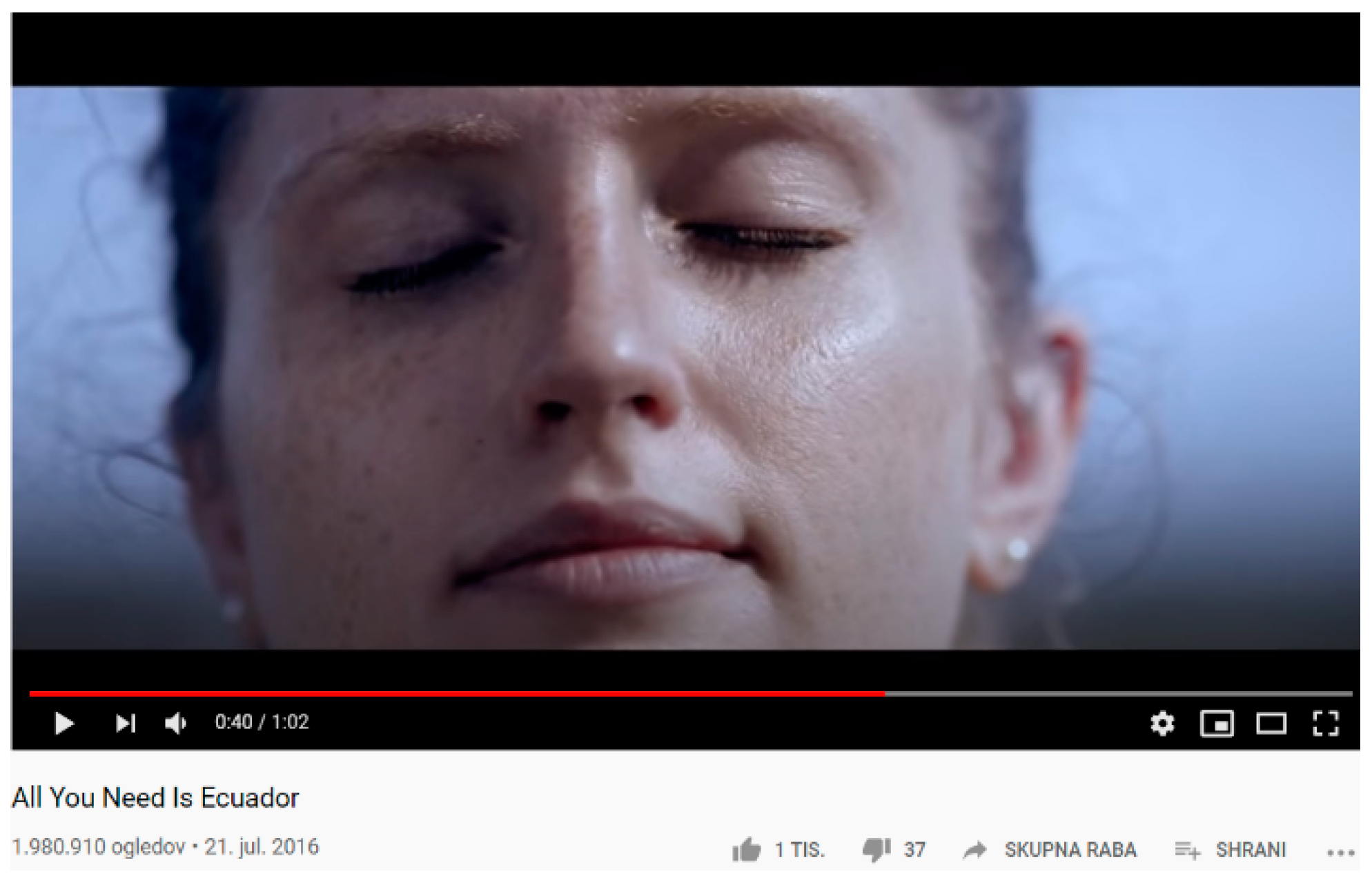
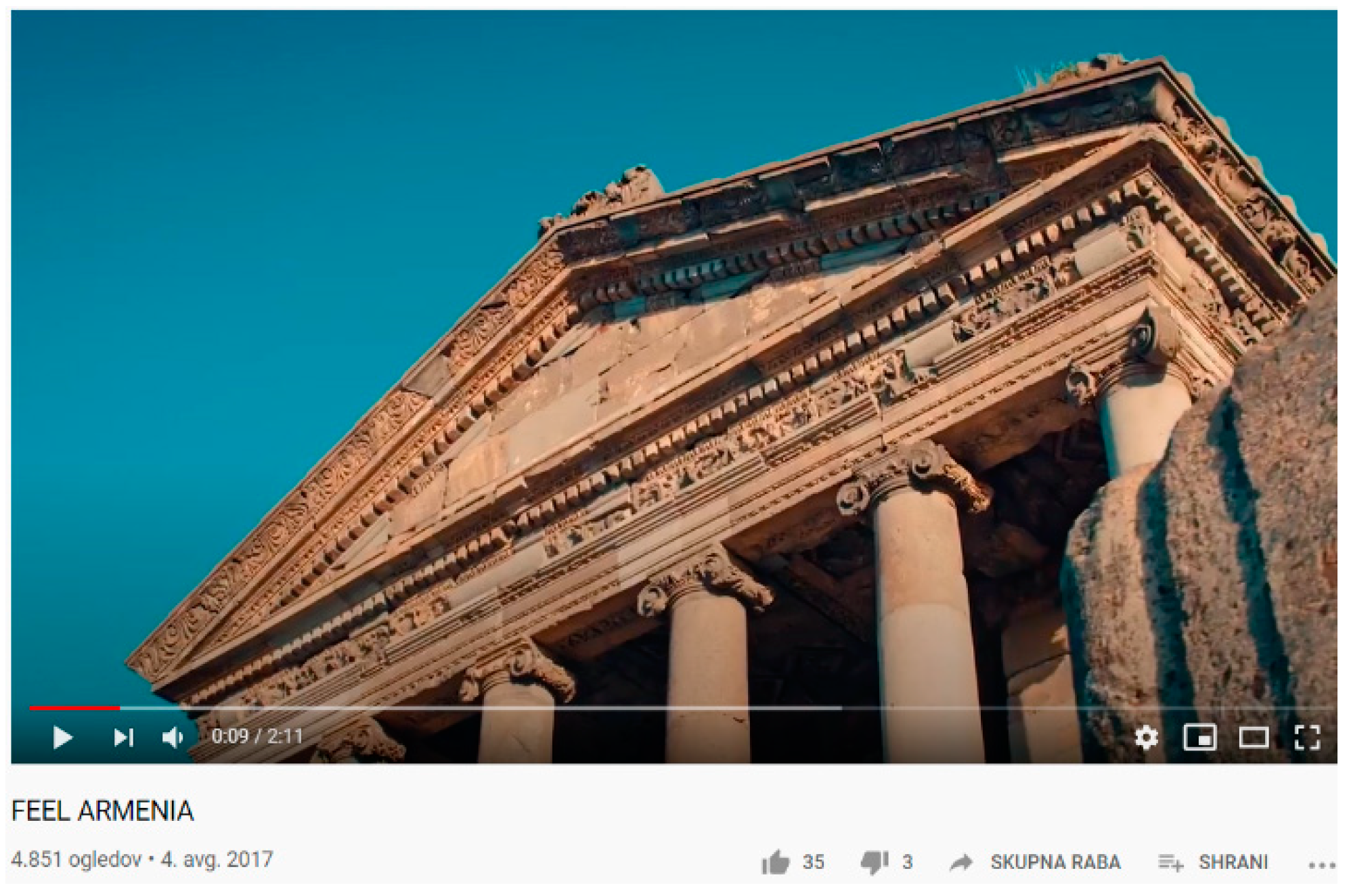
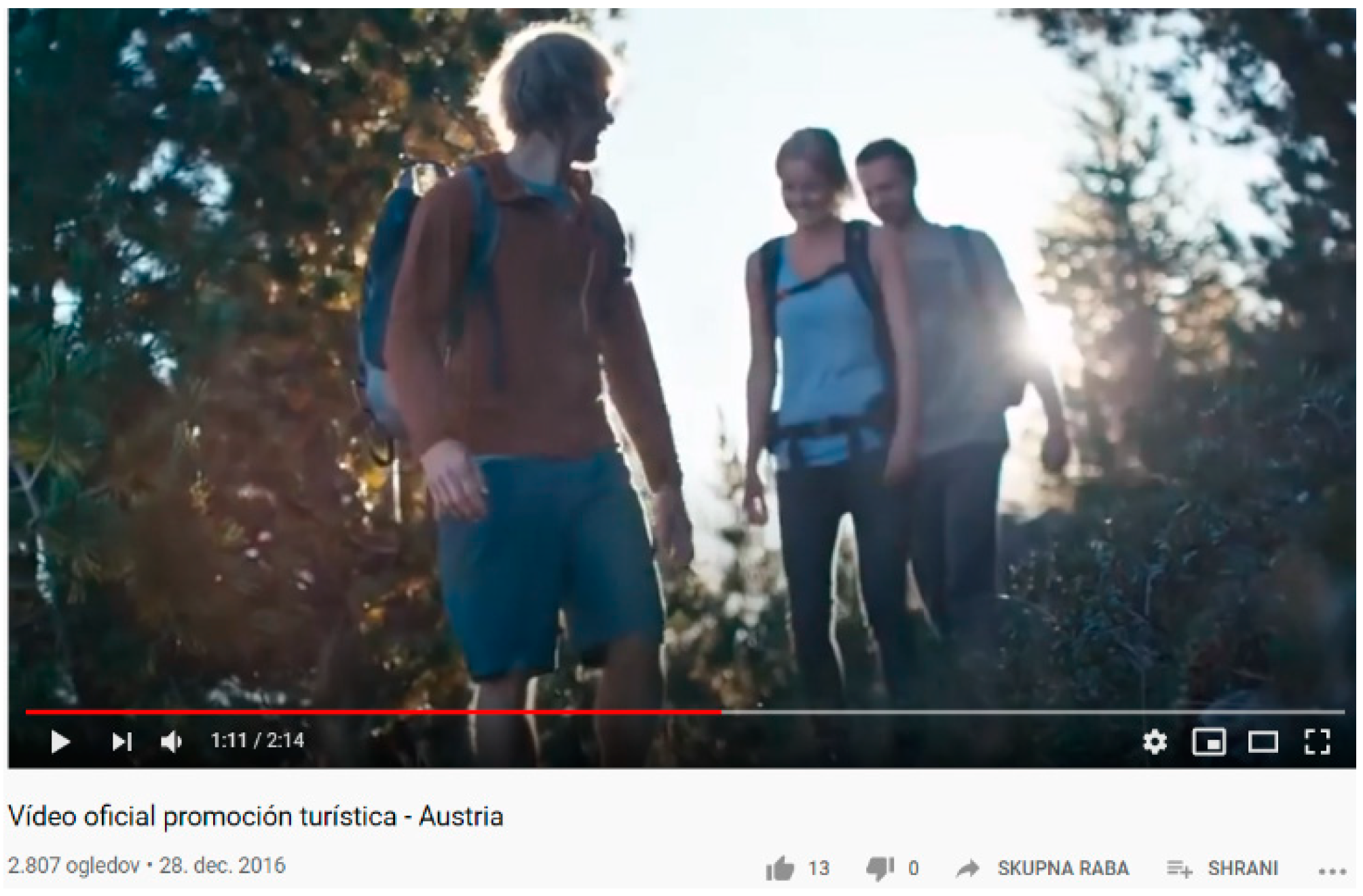
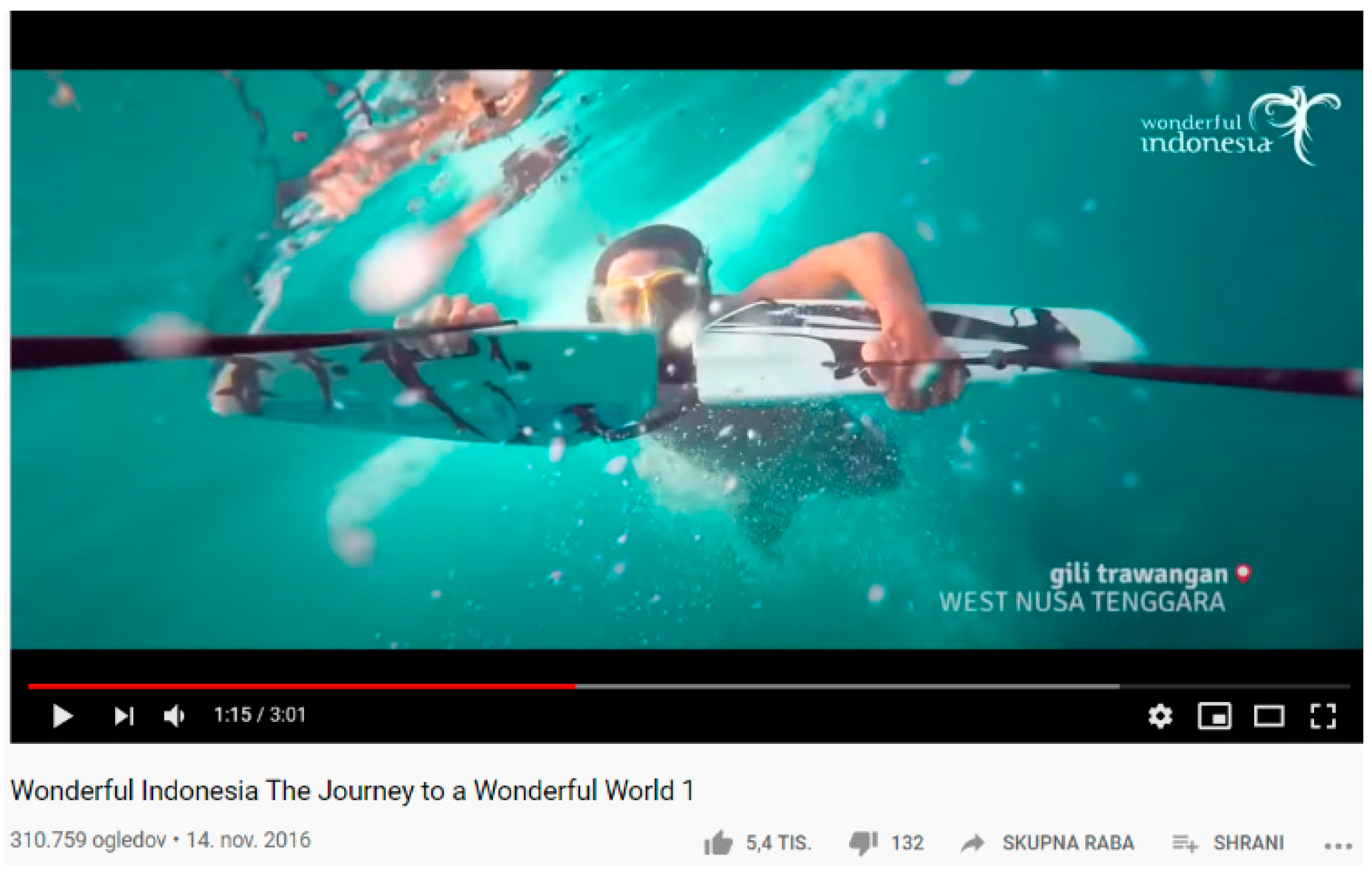
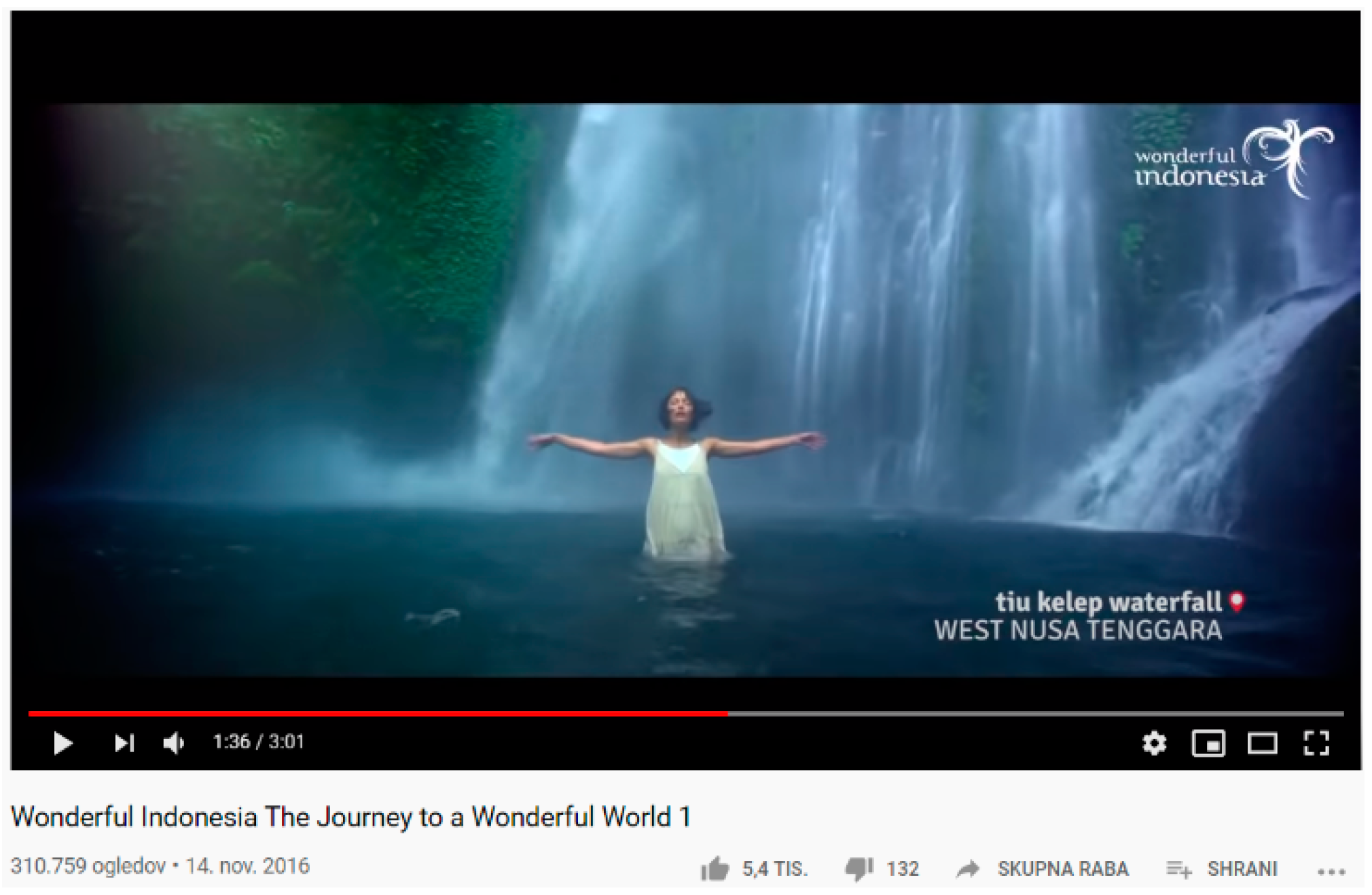
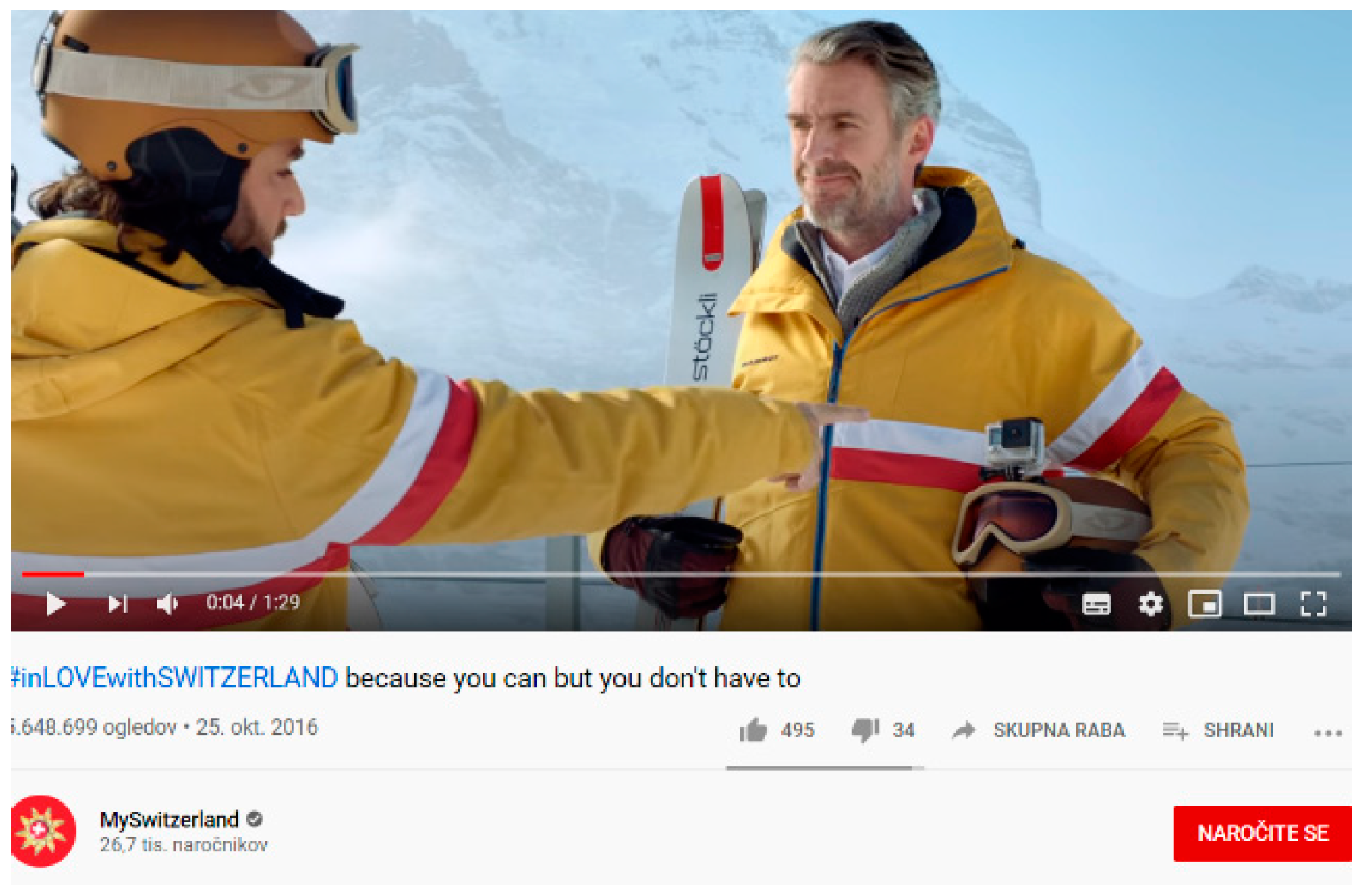
| Textual Transcription of Video Sequences: Value Propositions Identified in the Video | Fluency: Number of Value Propositions | Categories and Number of Sequences per Category | Flexibility: Number of Categories | Main Thematic Type |
|---|---|---|---|---|
| View of the castle on the slope and the city below it (1), boat ride down the river through the city (2), couple on a boat watching the surroundings (3), supping on the river through the town (4), cycling (5), playing golf (6), horses (7), displaying a lake and an older couple on a rowing boat (8), caption of a tourist’s comment »MIND-BLO-WING (9). “Like stepping right into a fairytale« (10), a couple sits on a terrace overlooking a lake (30) and drinks coffee and eats the traditional walnut cake (11), a father with his son playing on a beach with sand (12), jumping together in a swimming pool (13), a scene depicting a town market (14), a young couple trying food at the town market (15), followed by a bike ride (16), a couple in a spa (17), massage (18), rafting (19), a caption of a tourist’s comment “One of nature’s gifts to the world” (20), a display of a seaside town and port (21), a couple strolling through the streets and taking pictures (22), a caption of a tourist’s comment “You will fall in love with the place” (23), pouring wine into a glass (24), displaying food (25), underground cave with stalactites and stalagmites (26), a man hiking (27), a young couple watching the sunset by the sea (28), logotype and slogan “Slovenia. Make new memories.” (29) [47] | 29 | tourist activities | 7 | Activities |
| nb. of sequences | ||||
| 13 | ||||
| Food | ||||
| nb. of sequences | ||||
| 5 | ||||
| cultural heritage | ||||
| nb. of sequences | ||||
| 2 | ||||
| Nature | ||||
| nb. of sequences | ||||
| 2 | ||||
| senses & wellbeing nb. of sequences | ||||
| 2 | ||||
| Fun | ||||
| nb. of sequences | ||||
| 1 | ||||
| Other | ||||
| nb. of sequences | ||||
| 5 | ||||
| Fluency (nb. of Value Propositions) | Flexibility (nb. of Categories of Value Propositions) | |
|---|---|---|
| Mean | 23.5 | 5.0 |
| Std. Deviation | 10.2 | 1.5 |
| Minimum | 3 | 1 |
| Maximum | 59 | 8 |
| Content Video Type | Frequency | % |
|---|---|---|
| Emotions | 31 | 51 |
| Heritage | 16 | 26 |
| Activities | 9 | 15 |
| Mixed | 5 | 8 |
| Total | 61 | 100 |
| Percentages of Sequences per Category | ||||||||
|---|---|---|---|---|---|---|---|---|
| General Tourism Activities | Nature | Cultural Heritage | Fun/Dance | Activities with Hosts | Senses | Food | Music | |
| % of videos * | 84% | 77% | 72% | 72% | 54% | 30% | 6% | 3% |
| Mean | 5.4 | 4.2 | 3.0 | 2.2 | 1.6 | 0.7 | 0.4 | 0.2 |
| Stdandard Deviation | 4.0 | 3.7 | 3.4 | 2.3 | 2.4 | 1.4 | 1.1 | 1.0 |
| Maximum | 17 | 13 | 12 | 9 | 12 | 6 | 5 | 7 |
| Frequency | % | |
|---|---|---|
| Storytelling | 9 | 15 |
| One or two storytelling elements present | 16 | 26 |
| Collage | 16 | 26 |
| Other or undefined | 5 | 8 |
| Total | 61 | 100 |
| Frequency | % | |
|---|---|---|
| No | 51 | 83.6 |
| Yes | 10 | 16.4 |
| Total | 61 | 100 |
Publisher’s Note: MDPI stays neutral with regard to jurisdictional claims in published maps and institutional affiliations. |
© 2020 by the authors. Licensee MDPI, Basel, Switzerland. This article is an open access article distributed under the terms and conditions of the Creative Commons Attribution (CC BY) license (http://creativecommons.org/licenses/by/4.0/).
Share and Cite
Alegro, T.; Turnšek, M. Striving to Be Different but Becoming the Same: Creativity and Destination Brands’ Promotional Videos. Sustainability 2021, 13, 139. https://doi.org/10.3390/su13010139
Alegro T, Turnšek M. Striving to Be Different but Becoming the Same: Creativity and Destination Brands’ Promotional Videos. Sustainability. 2021; 13(1):139. https://doi.org/10.3390/su13010139
Chicago/Turabian StyleAlegro, Tjaša, and Maja Turnšek. 2021. "Striving to Be Different but Becoming the Same: Creativity and Destination Brands’ Promotional Videos" Sustainability 13, no. 1: 139. https://doi.org/10.3390/su13010139
APA StyleAlegro, T., & Turnšek, M. (2021). Striving to Be Different but Becoming the Same: Creativity and Destination Brands’ Promotional Videos. Sustainability, 13(1), 139. https://doi.org/10.3390/su13010139






